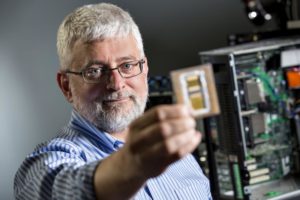 Today IEEE announced the next milestone phase in the development of the International Roadmap for Devices and Systems (IRDS) with the launch of a series of nine white papers that reinforce the initiative’s core mission and vision for the future of the computing industry. The white papers also identify industry challenges and solutions that guide and support future roadmaps created by IRDS.
Today IEEE announced the next milestone phase in the development of the International Roadmap for Devices and Systems (IRDS) with the launch of a series of nine white papers that reinforce the initiative’s core mission and vision for the future of the computing industry. The white papers also identify industry challenges and solutions that guide and support future roadmaps created by IRDS.
Representing the foundational development stage in IRDS is the publishing of nine white papers that outline the vital and technical components required to create a roadmap,” said Paolo A. Gargini, IEEE Fellow and Chairman of IRDS. “As a team, we are laying the foundation to identify challenges and recommendations on possible solutions to the industry’s current limitations defined by Moore’s Law. With the launch of the nine white papers on our new website, the IRDS roadmap sets the path for the industry benefiting from all fresh levels of processing power, energy efficiency, and technologies yet to be discovered.”
IEEE is taking a lead role in building a comprehensive, end-to-end view of the computing ecosystem, including devices, components, systems, architecture, and software. In May 2016, IEEE announced the formation of the IRDS under the sponsorship of IEEE RC. The historical integration of IEEE RC and the International Technology Roadmap for Semiconductors (ITRS) 2.0 addresses mapping the ecosystem of the new reborn electronics industry. The new beginning of the evolved roadmap—with the migration from ITRS to IRDS—is proceeding seamlessly as all the reports produced by the ITRS 2.0 represent the starting point of IRDS.
While engaging other segments of IEEE in complementary activities to assure alignment and consensus across a range of stakeholders, the IRDS team is developing a 15-year roadmap with a vision to identify key trends related to devices, systems, and other related technologies.
The IRDS has taken a significant step in creating the industry roadmap by publishing nine technical white papers,” said IEEE Fellow Elie Track, 2011-2014 President, IEEE Council on Superconductivity; Co-chair, IEEE RC; and CEO of nVizix. “Through the public availability of these white papers, we’re inviting computing professionals to participate in creating an innovative ecosystem that will set a new direction for the greater good of the industry. Today, I open an invitation to get involved with IEEE RC and the IRDS.”
The series of white papers delivers the starting framework of the IRDS roadmap—and through the sponsorship of IEEE RC—will inform the various roadmap teams in the broader task of mapping the devices’ and systems’ ecosystem:
- Application Benchmarking (PDF)
- More Moore (PDF)
- Beyond CMOS (PDF)
- Outside System Connectivity (PDFB)
- Factory Integration (PDF)
- Metrology (PDF)
- Environment, Health, and Safety (PDF)
- Yield (PDF)
- System and Architecture (Preliminary) (PDF)
“IEEE is the perfect place to foster the IRDS roadmap and fulfill what the computing industry has been searching for over the past decades,” said IEEE Fellow Thomas M. Conte, 2015 President, IEEE Computer Society; Co-chair, IEEE RC; and Professor, Schools of Computer Science, and Electrical and Computer Engineering, Georgia Institute of Technology. “In essence, we’re creating a new Moore’s Law. And we have so many next-generation computing solutions that could easily help us reach uncharted performance heights, including cryogenic computing, reversible computing, quantum computing, neuromorphic computing, superconducting computing, and others. And that’s why the IEEE RC Initiative exists: creating and maintaining a forum for the experts who will usher the industry beyond the Moore’s Law we know today.”
The IRDS leadership team hosted a winter workshop and kick-off meeting at the Georgia Institute of Technology on 1-2 December 2016. Key discoveries from the workshop included the international focus teams’ plans and focus topics for the 2017 roadmap, top-level needs and challenges, and linkages among the teams. Additionally, the IRDS leadership invited presentations from the European and Japanese roadmap initiatives. This resulted in the 2017 IRDS global membership expanding to include team members from the “NanoElectronics Roadmap for Europe: Identification and Dissemination” (NEREID) sponsored by the European Semiconductor Industry Association (ESIA), and the “Systems and Design Roadmap of Japan” (SDRJ) sponsored by the Japan Society of Applied Physics (JSAP).

Tom Conte, IEEE Rebooting Computing co-chair and professor for the Georgia Tech schools of Computer Science and Electrical & Computer Engineering
The IRDS team and its supporters will convene 1-3 April 2017 in Monterey, California, for the Spring IRDS Workshop, which is part of the 2017 IEEE International Reliability Physics Symposium (IRPS). The team will meet again for the Fall IRDS Conference—in partnership with the 2017 IEEE International Conference on Rebooting Computing (ICRC)—scheduled for 6-7 November 2017 in Washington, D.C.



